Online Research Methods Assessment - Desklib
VerifiedAdded on 2023/06/09
|16
|2780
|289
AI Summary
This assessment covers research development and design, statistical analysis, data analysis and write-up, and assumption checks. It includes a study on the impact of depression on mental well-being and a statistical decision-making process.
Contribute Materials
Your contribution can guide someone’s learning journey. Share your
documents today.
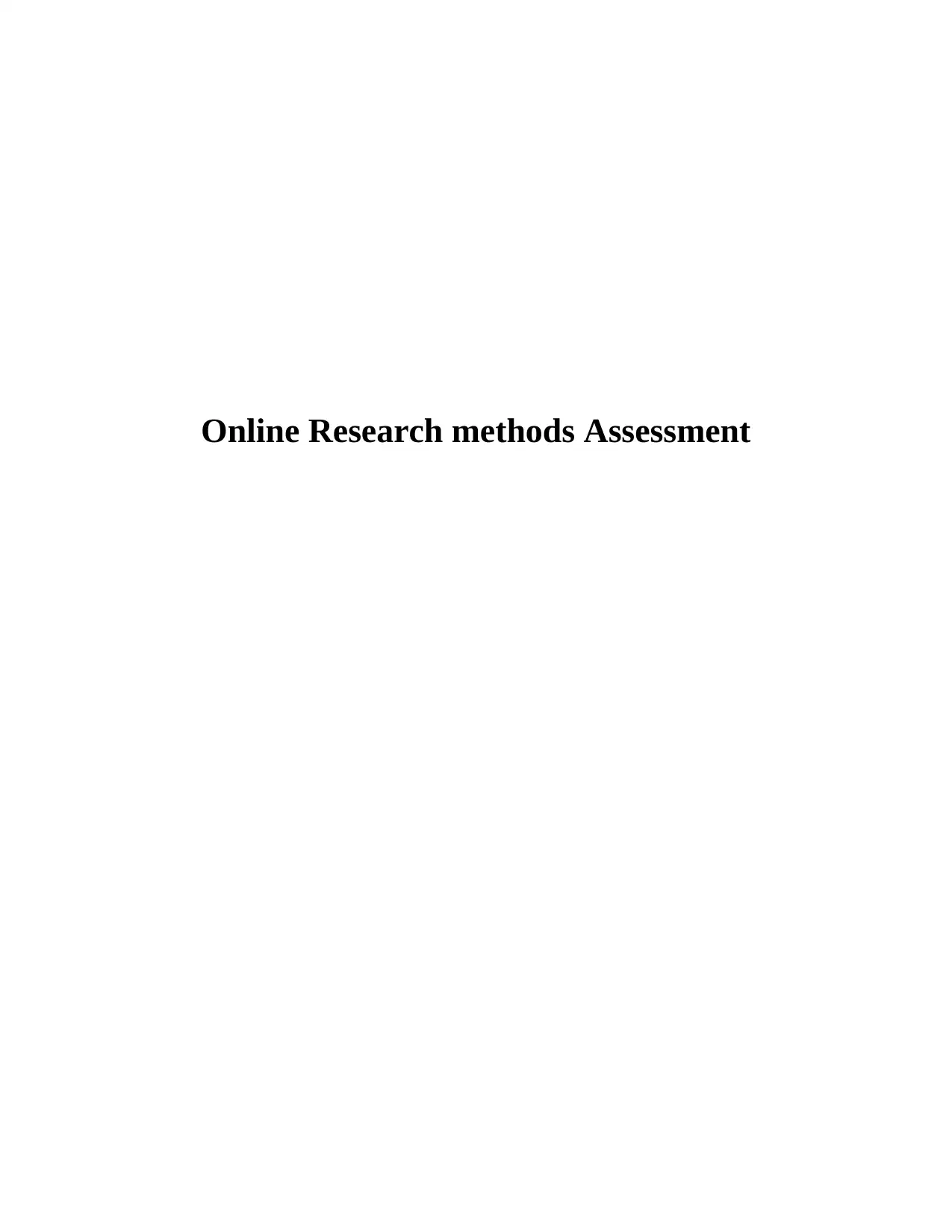
Online Research methods Assessment
Secure Best Marks with AI Grader
Need help grading? Try our AI Grader for instant feedback on your assignments.
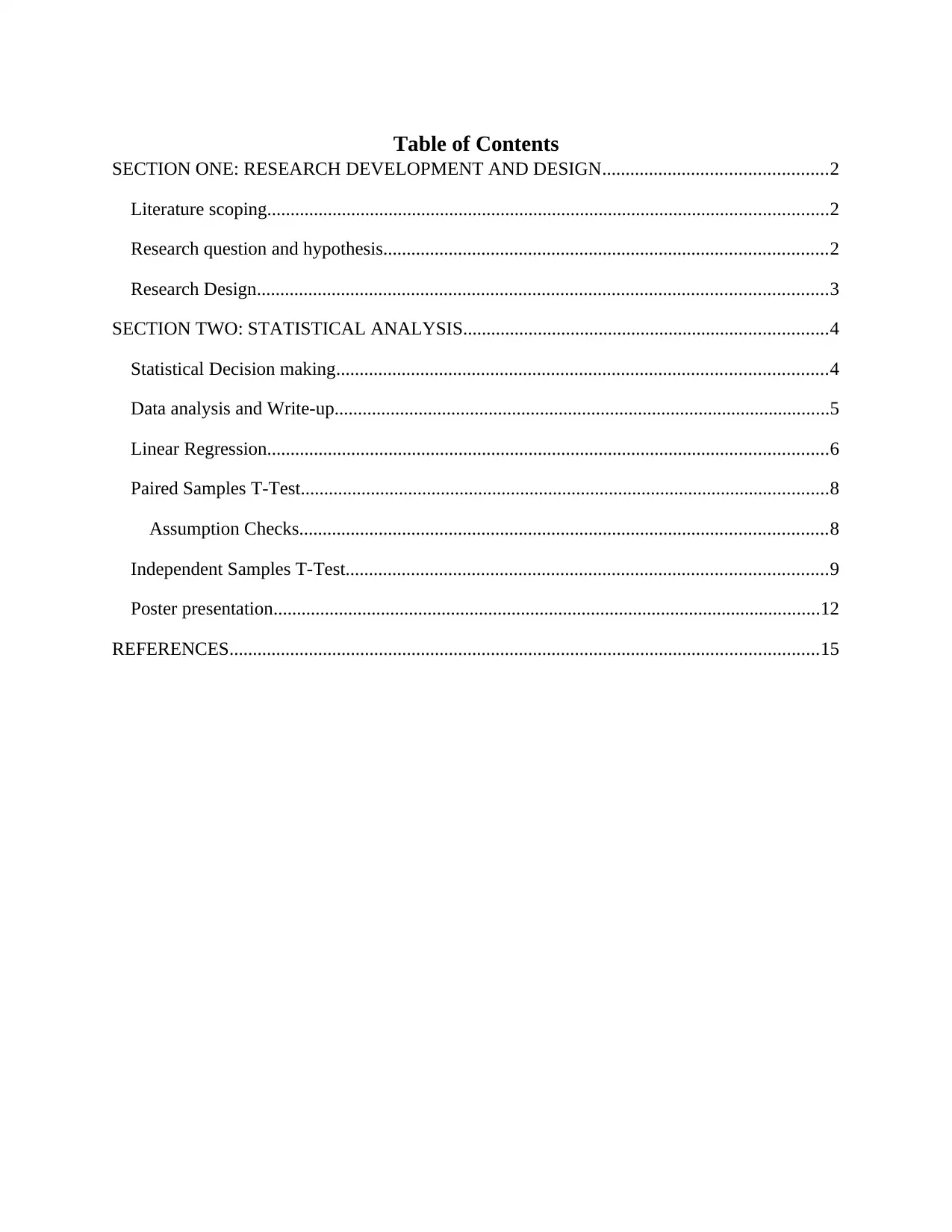
Table of Contents
SECTION ONE: RESEARCH DEVELOPMENT AND DESIGN................................................2
Literature scoping........................................................................................................................2
Research question and hypothesis...............................................................................................2
Research Design..........................................................................................................................3
SECTION TWO: STATISTICAL ANALYSIS..............................................................................4
Statistical Decision making.........................................................................................................4
Data analysis and Write-up..........................................................................................................5
Linear Regression........................................................................................................................6
Paired Samples T-Test.................................................................................................................8
Assumption Checks.................................................................................................................8
Independent Samples T-Test.......................................................................................................9
Poster presentation.....................................................................................................................12
REFERENCES..............................................................................................................................15
SECTION ONE: RESEARCH DEVELOPMENT AND DESIGN................................................2
Literature scoping........................................................................................................................2
Research question and hypothesis...............................................................................................2
Research Design..........................................................................................................................3
SECTION TWO: STATISTICAL ANALYSIS..............................................................................4
Statistical Decision making.........................................................................................................4
Data analysis and Write-up..........................................................................................................5
Linear Regression........................................................................................................................6
Paired Samples T-Test.................................................................................................................8
Assumption Checks.................................................................................................................8
Independent Samples T-Test.......................................................................................................9
Poster presentation.....................................................................................................................12
REFERENCES..............................................................................................................................15

SECTION ONE: RESEARCH DEVELOPMENT AND DESIGN
Literature scoping
Depression in youth is considered as a major issue for the young adults. Also, there were
many studies that has already conducted which entails that there is a negative impact identified
over the mental health of the people (Weersing and et.al., 2017). Further, it has been identified
that almost one in five adults were likely to be experiencing depression which will be increases
when the effective steps have not taken. Moreover, in the past decades, several different types of
psychotherapy for depression have been developed and as a result, the term defined as a the
informed and intentional application of clinical methods that is compiled of different principle
related to the same. Also, if such rate of mental illness increases from last many years then it
affects the overall mental health of people in negative manner (Cuijpers and et.al., 2019).
Majority of the depressed patients are mainly treated in primary care and for that small portion of
these are referred to mental health services. Instead of hundred trials on drugs and therapy, some
limited number of trials on drugs are mainly focused upon the primary care patients. Therefore,
the results are based upon the mental health care and this is not valid in depressed primary care
patients. So, the current study shed a light upon how the mental illness affected when the person
is depressed and for that primary research has to be conducted that provide a fair result.
The chosen topic for the present study is to determine the impact of depression upon the
mental wellbeing of the adults. Also, there are different treatment and treatment offered that
helps to let them know about how depression may cause negative impact over their health.
Therefore, the rationale for choosing this particular topic is to determine the views of people
towards the selected research questions.
Research question and hypothesis
The research question for the study is such that What is the impact of depression upon
adult’s mental well-being.
Hypothesis:
H0 (Null hypothesis): There is no relationship between the mean value of adult’s well-being.
Literature scoping
Depression in youth is considered as a major issue for the young adults. Also, there were
many studies that has already conducted which entails that there is a negative impact identified
over the mental health of the people (Weersing and et.al., 2017). Further, it has been identified
that almost one in five adults were likely to be experiencing depression which will be increases
when the effective steps have not taken. Moreover, in the past decades, several different types of
psychotherapy for depression have been developed and as a result, the term defined as a the
informed and intentional application of clinical methods that is compiled of different principle
related to the same. Also, if such rate of mental illness increases from last many years then it
affects the overall mental health of people in negative manner (Cuijpers and et.al., 2019).
Majority of the depressed patients are mainly treated in primary care and for that small portion of
these are referred to mental health services. Instead of hundred trials on drugs and therapy, some
limited number of trials on drugs are mainly focused upon the primary care patients. Therefore,
the results are based upon the mental health care and this is not valid in depressed primary care
patients. So, the current study shed a light upon how the mental illness affected when the person
is depressed and for that primary research has to be conducted that provide a fair result.
The chosen topic for the present study is to determine the impact of depression upon the
mental wellbeing of the adults. Also, there are different treatment and treatment offered that
helps to let them know about how depression may cause negative impact over their health.
Therefore, the rationale for choosing this particular topic is to determine the views of people
towards the selected research questions.
Research question and hypothesis
The research question for the study is such that What is the impact of depression upon
adult’s mental well-being.
Hypothesis:
H0 (Null hypothesis): There is no relationship between the mean value of adult’s well-being.
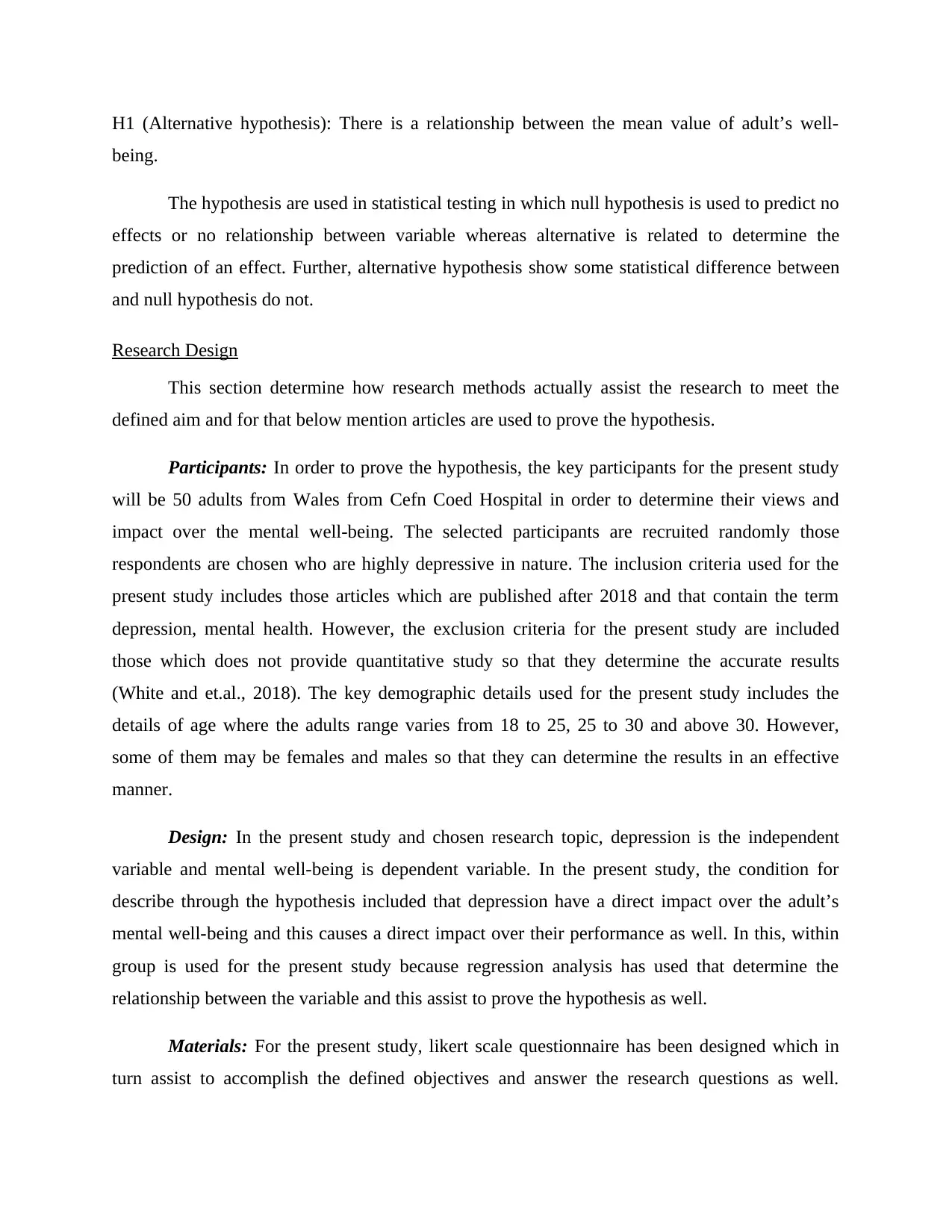
H1 (Alternative hypothesis): There is a relationship between the mean value of adult’s well-
being.
The hypothesis are used in statistical testing in which null hypothesis is used to predict no
effects or no relationship between variable whereas alternative is related to determine the
prediction of an effect. Further, alternative hypothesis show some statistical difference between
and null hypothesis do not.
Research Design
This section determine how research methods actually assist the research to meet the
defined aim and for that below mention articles are used to prove the hypothesis.
Participants: In order to prove the hypothesis, the key participants for the present study
will be 50 adults from Wales from Cefn Coed Hospital in order to determine their views and
impact over the mental well-being. The selected participants are recruited randomly those
respondents are chosen who are highly depressive in nature. The inclusion criteria used for the
present study includes those articles which are published after 2018 and that contain the term
depression, mental health. However, the exclusion criteria for the present study are included
those which does not provide quantitative study so that they determine the accurate results
(White and et.al., 2018). The key demographic details used for the present study includes the
details of age where the adults range varies from 18 to 25, 25 to 30 and above 30. However,
some of them may be females and males so that they can determine the results in an effective
manner.
Design: In the present study and chosen research topic, depression is the independent
variable and mental well-being is dependent variable. In the present study, the condition for
describe through the hypothesis included that depression have a direct impact over the adult’s
mental well-being and this causes a direct impact over their performance as well. In this, within
group is used for the present study because regression analysis has used that determine the
relationship between the variable and this assist to prove the hypothesis as well.
Materials: For the present study, likert scale questionnaire has been designed which in
turn assist to accomplish the defined objectives and answer the research questions as well.
being.
The hypothesis are used in statistical testing in which null hypothesis is used to predict no
effects or no relationship between variable whereas alternative is related to determine the
prediction of an effect. Further, alternative hypothesis show some statistical difference between
and null hypothesis do not.
Research Design
This section determine how research methods actually assist the research to meet the
defined aim and for that below mention articles are used to prove the hypothesis.
Participants: In order to prove the hypothesis, the key participants for the present study
will be 50 adults from Wales from Cefn Coed Hospital in order to determine their views and
impact over the mental well-being. The selected participants are recruited randomly those
respondents are chosen who are highly depressive in nature. The inclusion criteria used for the
present study includes those articles which are published after 2018 and that contain the term
depression, mental health. However, the exclusion criteria for the present study are included
those which does not provide quantitative study so that they determine the accurate results
(White and et.al., 2018). The key demographic details used for the present study includes the
details of age where the adults range varies from 18 to 25, 25 to 30 and above 30. However,
some of them may be females and males so that they can determine the results in an effective
manner.
Design: In the present study and chosen research topic, depression is the independent
variable and mental well-being is dependent variable. In the present study, the condition for
describe through the hypothesis included that depression have a direct impact over the adult’s
mental well-being and this causes a direct impact over their performance as well. In this, within
group is used for the present study because regression analysis has used that determine the
relationship between the variable and this assist to prove the hypothesis as well.
Materials: For the present study, likert scale questionnaire has been designed which in
turn assist to accomplish the defined objectives and answer the research questions as well.
Secure Best Marks with AI Grader
Need help grading? Try our AI Grader for instant feedback on your assignments.
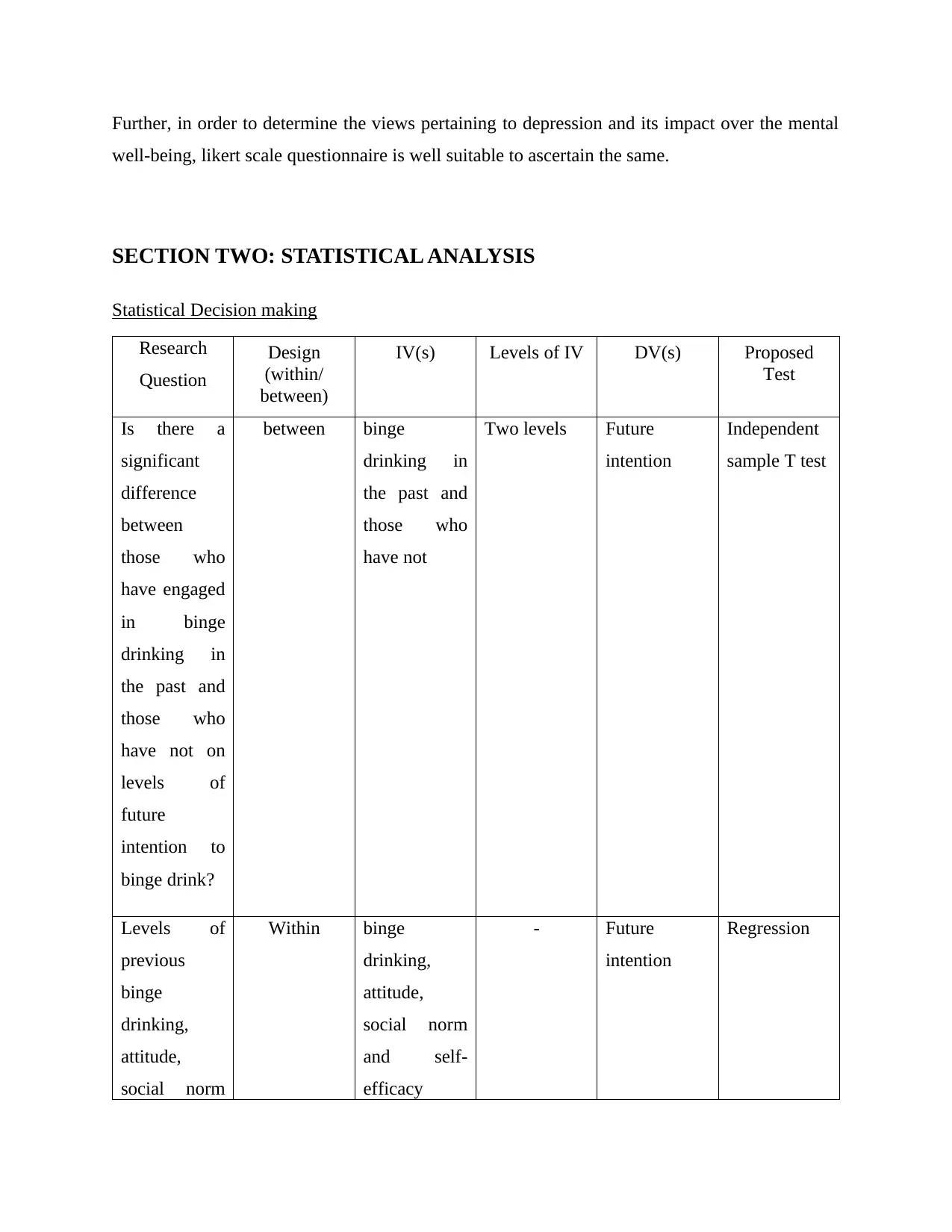
Further, in order to determine the views pertaining to depression and its impact over the mental
well-being, likert scale questionnaire is well suitable to ascertain the same.
SECTION TWO: STATISTICAL ANALYSIS
Statistical Decision making
Research
Question
Design
(within/
between)
IV(s) Levels of IV DV(s) Proposed
Test
Is there a
significant
difference
between
those who
have engaged
in binge
drinking in
the past and
those who
have not on
levels of
future
intention to
binge drink?
between binge
drinking in
the past and
those who
have not
Two levels Future
intention
Independent
sample T test
Levels of
previous
binge
drinking,
attitude,
social norm
Within binge
drinking,
attitude,
social norm
and self-
efficacy
- Future
intention
Regression
well-being, likert scale questionnaire is well suitable to ascertain the same.
SECTION TWO: STATISTICAL ANALYSIS
Statistical Decision making
Research
Question
Design
(within/
between)
IV(s) Levels of IV DV(s) Proposed
Test
Is there a
significant
difference
between
those who
have engaged
in binge
drinking in
the past and
those who
have not on
levels of
future
intention to
binge drink?
between binge
drinking in
the past and
those who
have not
Two levels Future
intention
Independent
sample T test
Levels of
previous
binge
drinking,
attitude,
social norm
Within binge
drinking,
attitude,
social norm
and self-
efficacy
- Future
intention
Regression

and self-
efficacy
significantly
predict future
intention to
binge drink?
significantly
Is there a
significant
difference
between
congruent
and
incongruent
reaction
times?
Between Congruent
reaction
times
One level Incongruent
reaction
times
Paired T Test
Is there a
significant
interaction
between
ethnicity and
implicit
association?
Within Ethnicity Two level Implicit
association
Independent
sample T test
Data analysis and Write-up
Set one:
efficacy
significantly
predict future
intention to
binge drink?
significantly
Is there a
significant
difference
between
congruent
and
incongruent
reaction
times?
Between Congruent
reaction
times
One level Incongruent
reaction
times
Paired T Test
Is there a
significant
interaction
between
ethnicity and
implicit
association?
Within Ethnicity Two level Implicit
association
Independent
sample T test
Data analysis and Write-up
Set one:
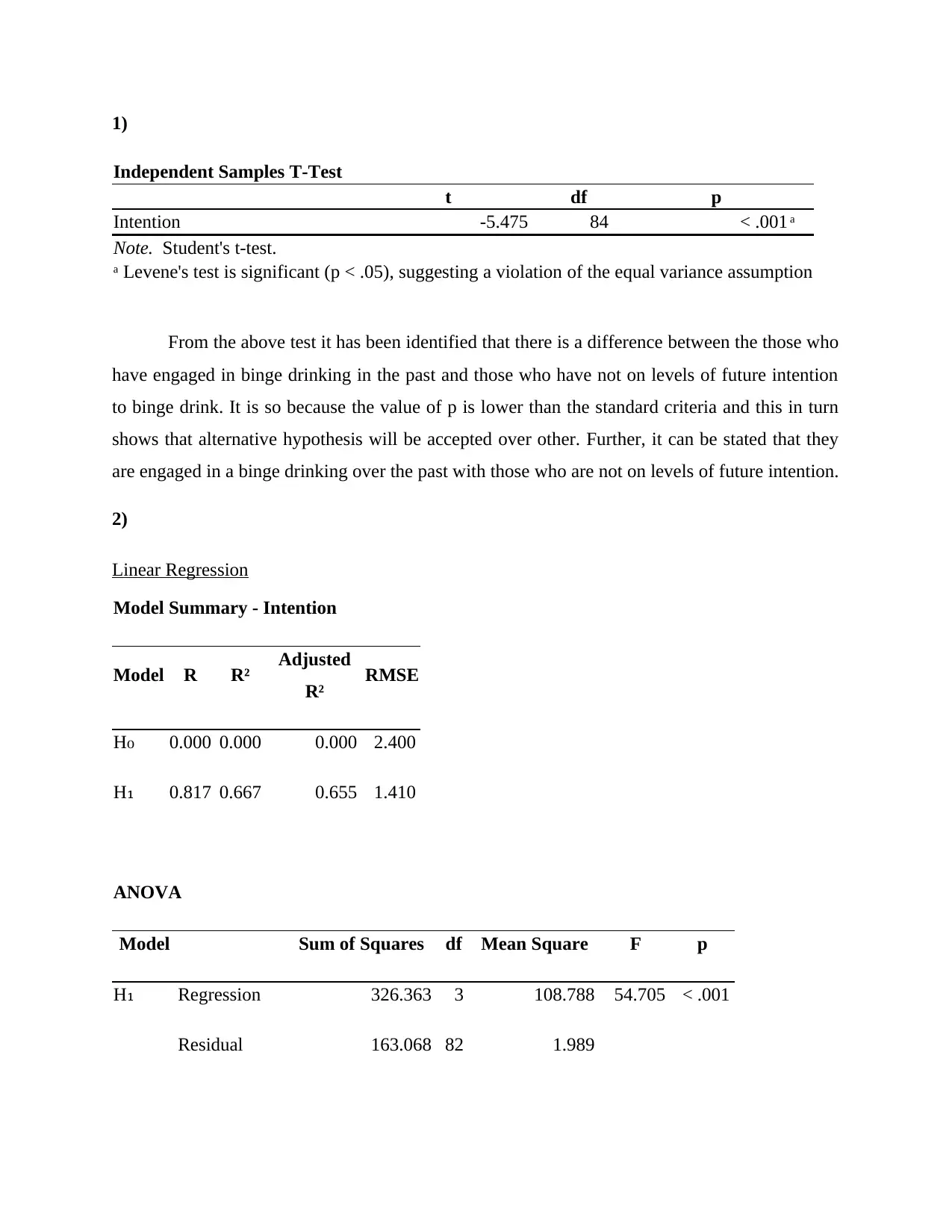
1)
Independent Samples T-Test
t df p
Intention -5.475 84 < .001 ᵃ
Note. Student's t-test.
ᵃ Levene's test is significant (p < .05), suggesting a violation of the equal variance assumption
From the above test it has been identified that there is a difference between the those who
have engaged in binge drinking in the past and those who have not on levels of future intention
to binge drink. It is so because the value of p is lower than the standard criteria and this in turn
shows that alternative hypothesis will be accepted over other. Further, it can be stated that they
are engaged in a binge drinking over the past with those who are not on levels of future intention.
2)
Linear Regression
Model Summary - Intention
Model R R² Adjusted
R² RMSE
H₀ 0.000 0.000 0.000 2.400
H₁ 0.817 0.667 0.655 1.410
ANOVA
Model Sum of Squares df Mean Square F p
H₁ Regression 326.363 3 108.788 54.705 < .001
Residual 163.068 82 1.989
Independent Samples T-Test
t df p
Intention -5.475 84 < .001 ᵃ
Note. Student's t-test.
ᵃ Levene's test is significant (p < .05), suggesting a violation of the equal variance assumption
From the above test it has been identified that there is a difference between the those who
have engaged in binge drinking in the past and those who have not on levels of future intention
to binge drink. It is so because the value of p is lower than the standard criteria and this in turn
shows that alternative hypothesis will be accepted over other. Further, it can be stated that they
are engaged in a binge drinking over the past with those who are not on levels of future intention.
2)
Linear Regression
Model Summary - Intention
Model R R² Adjusted
R² RMSE
H₀ 0.000 0.000 0.000 2.400
H₁ 0.817 0.667 0.655 1.410
ANOVA
Model Sum of Squares df Mean Square F p
H₁ Regression 326.363 3 108.788 54.705 < .001
Residual 163.068 82 1.989
Paraphrase This Document
Need a fresh take? Get an instant paraphrase of this document with our AI Paraphraser
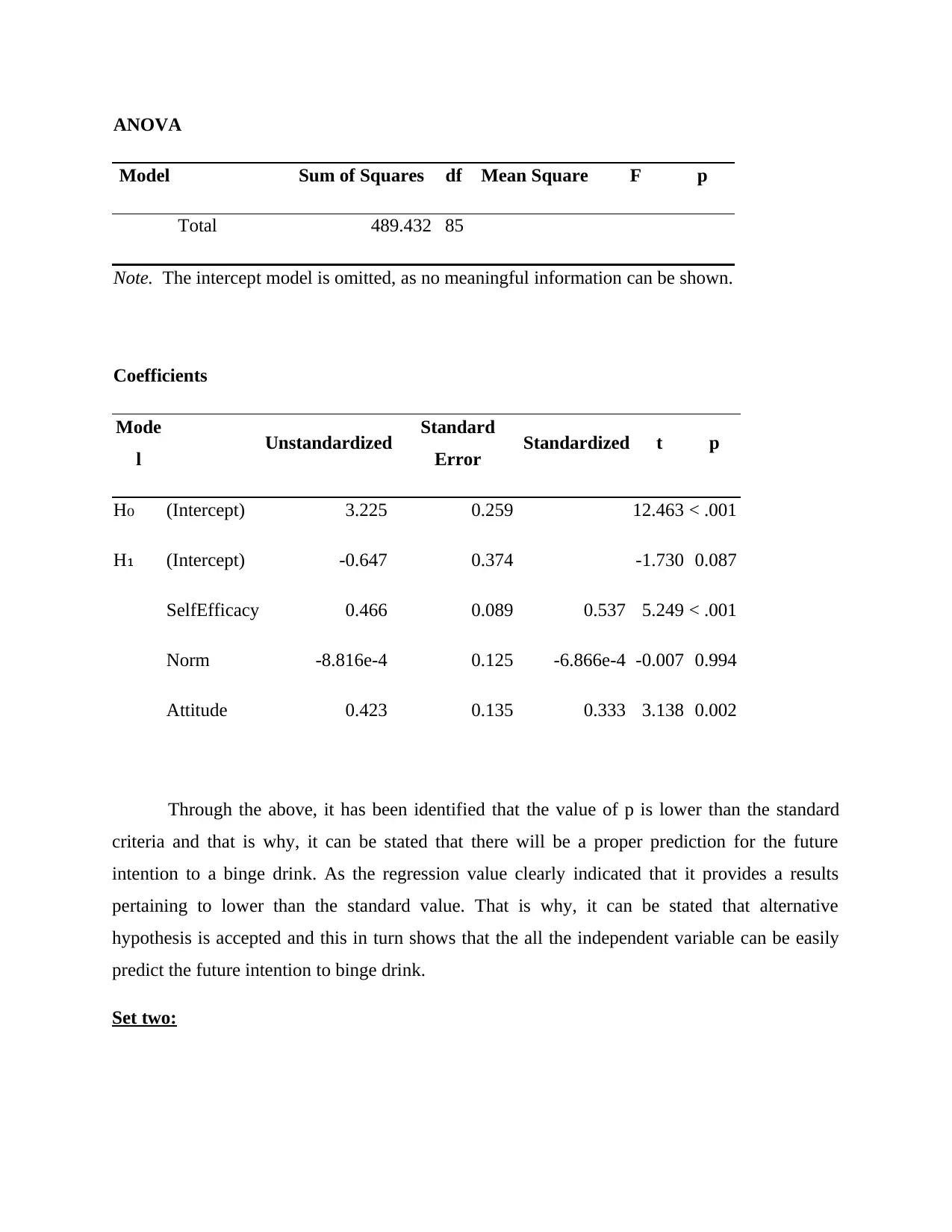
ANOVA
Model Sum of Squares df Mean Square F p
Total 489.432 85
Note. The intercept model is omitted, as no meaningful information can be shown.
Coefficients
Mode
l Unstandardized Standard
Error Standardized t p
H₀ (Intercept) 3.225 0.259 12.463 < .001
H₁ (Intercept) -0.647 0.374 -1.730 0.087
SelfEfficacy 0.466 0.089 0.537 5.249 < .001
Norm -8.816e-4 0.125 -6.866e-4 -0.007 0.994
Attitude 0.423 0.135 0.333 3.138 0.002
Through the above, it has been identified that the value of p is lower than the standard
criteria and that is why, it can be stated that there will be a proper prediction for the future
intention to a binge drink. As the regression value clearly indicated that it provides a results
pertaining to lower than the standard value. That is why, it can be stated that alternative
hypothesis is accepted and this in turn shows that the all the independent variable can be easily
predict the future intention to binge drink.
Set two:
Model Sum of Squares df Mean Square F p
Total 489.432 85
Note. The intercept model is omitted, as no meaningful information can be shown.
Coefficients
Mode
l Unstandardized Standard
Error Standardized t p
H₀ (Intercept) 3.225 0.259 12.463 < .001
H₁ (Intercept) -0.647 0.374 -1.730 0.087
SelfEfficacy 0.466 0.089 0.537 5.249 < .001
Norm -8.816e-4 0.125 -6.866e-4 -0.007 0.994
Attitude 0.423 0.135 0.333 3.138 0.002
Through the above, it has been identified that the value of p is lower than the standard
criteria and that is why, it can be stated that there will be a proper prediction for the future
intention to a binge drink. As the regression value clearly indicated that it provides a results
pertaining to lower than the standard value. That is why, it can be stated that alternative
hypothesis is accepted and this in turn shows that the all the independent variable can be easily
predict the future intention to binge drink.
Set two:
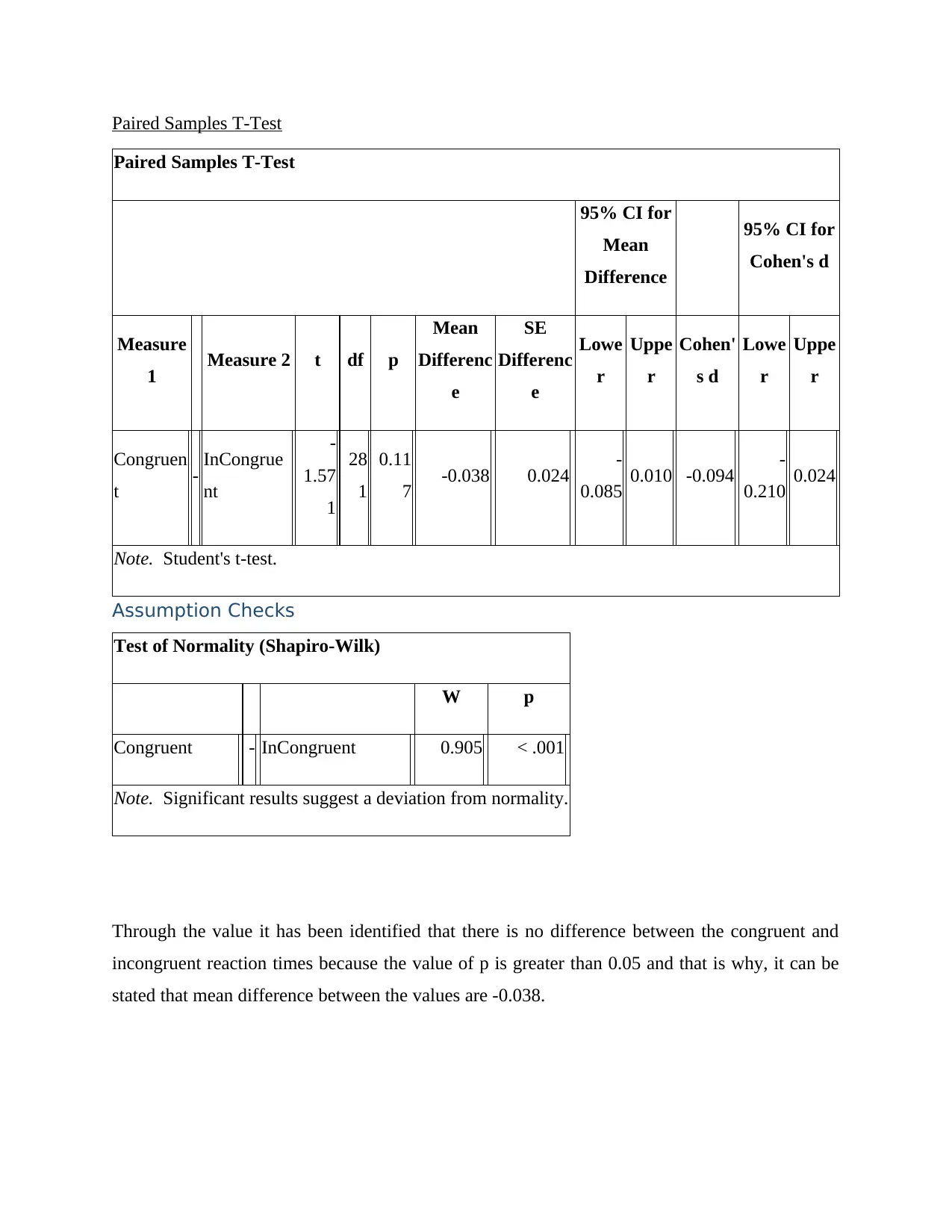
Paired Samples T-Test
Paired Samples T-Test
95% CI for
Mean
Difference
95% CI for
Cohen's d
Measure
1 Measure 2 t df p
Mean
Differenc
e
SE
Differenc
e
Lowe
r
Uppe
r
Cohen'
s d
Lowe
r
Uppe
r
Congruen
t - InCongrue
nt
-
1.57
1
28
1
0.11
7 -0.038 0.024 -
0.085 0.010 -0.094 -
0.210 0.024
Note. Student's t-test.
Assumption Checks
Test of Normality (Shapiro-Wilk)
W p
Congruent - InCongruent 0.905 < .001
Note. Significant results suggest a deviation from normality.
Through the value it has been identified that there is no difference between the congruent and
incongruent reaction times because the value of p is greater than 0.05 and that is why, it can be
stated that mean difference between the values are -0.038.
Paired Samples T-Test
95% CI for
Mean
Difference
95% CI for
Cohen's d
Measure
1 Measure 2 t df p
Mean
Differenc
e
SE
Differenc
e
Lowe
r
Uppe
r
Cohen'
s d
Lowe
r
Uppe
r
Congruen
t - InCongrue
nt
-
1.57
1
28
1
0.11
7 -0.038 0.024 -
0.085 0.010 -0.094 -
0.210 0.024
Note. Student's t-test.
Assumption Checks
Test of Normality (Shapiro-Wilk)
W p
Congruent - InCongruent 0.905 < .001
Note. Significant results suggest a deviation from normality.
Through the value it has been identified that there is no difference between the congruent and
incongruent reaction times because the value of p is greater than 0.05 and that is why, it can be
stated that mean difference between the values are -0.038.

Independent Samples T-Test
Independent Samples T-Test
95% CI for Mean
Difference
t df p Mean
Difference
SE
Difference Lower Upper Cohen's
d
Ethnicit
y
-
3.474 280 < .001 ᵃ -0.653 0.188 -∞ -0.343 -0.457
Note. For all tests, the alternative hypothesis specifies that group Male is less than group
Female .
Note. Student's t-test.
ᵃ Levene's test is significant (p < .05), suggesting a violation of the equal variance assumption
Through the above test, it has been identified that the value of ethnicity between the
values is lower than the standard criteria and this is why, it can be stated that there is an
interaction between ethnicity and implicit association. That is why, it can be stated that changes
in the views of male and females with regard to ethnicity actually varies and this in turn assist to
create a better outcome.
Descriptive statistics
Set one
1)
Independent Samples T-Test
95% CI for Mean
Difference
t df p Mean
Difference
SE
Difference Lower Upper Cohen's
d
Ethnicit
y
-
3.474 280 < .001 ᵃ -0.653 0.188 -∞ -0.343 -0.457
Note. For all tests, the alternative hypothesis specifies that group Male is less than group
Female .
Note. Student's t-test.
ᵃ Levene's test is significant (p < .05), suggesting a violation of the equal variance assumption
Through the above test, it has been identified that the value of ethnicity between the
values is lower than the standard criteria and this is why, it can be stated that there is an
interaction between ethnicity and implicit association. That is why, it can be stated that changes
in the views of male and females with regard to ethnicity actually varies and this in turn assist to
create a better outcome.
Descriptive statistics
Set one
1)
Secure Best Marks with AI Grader
Need help grading? Try our AI Grader for instant feedback on your assignments.
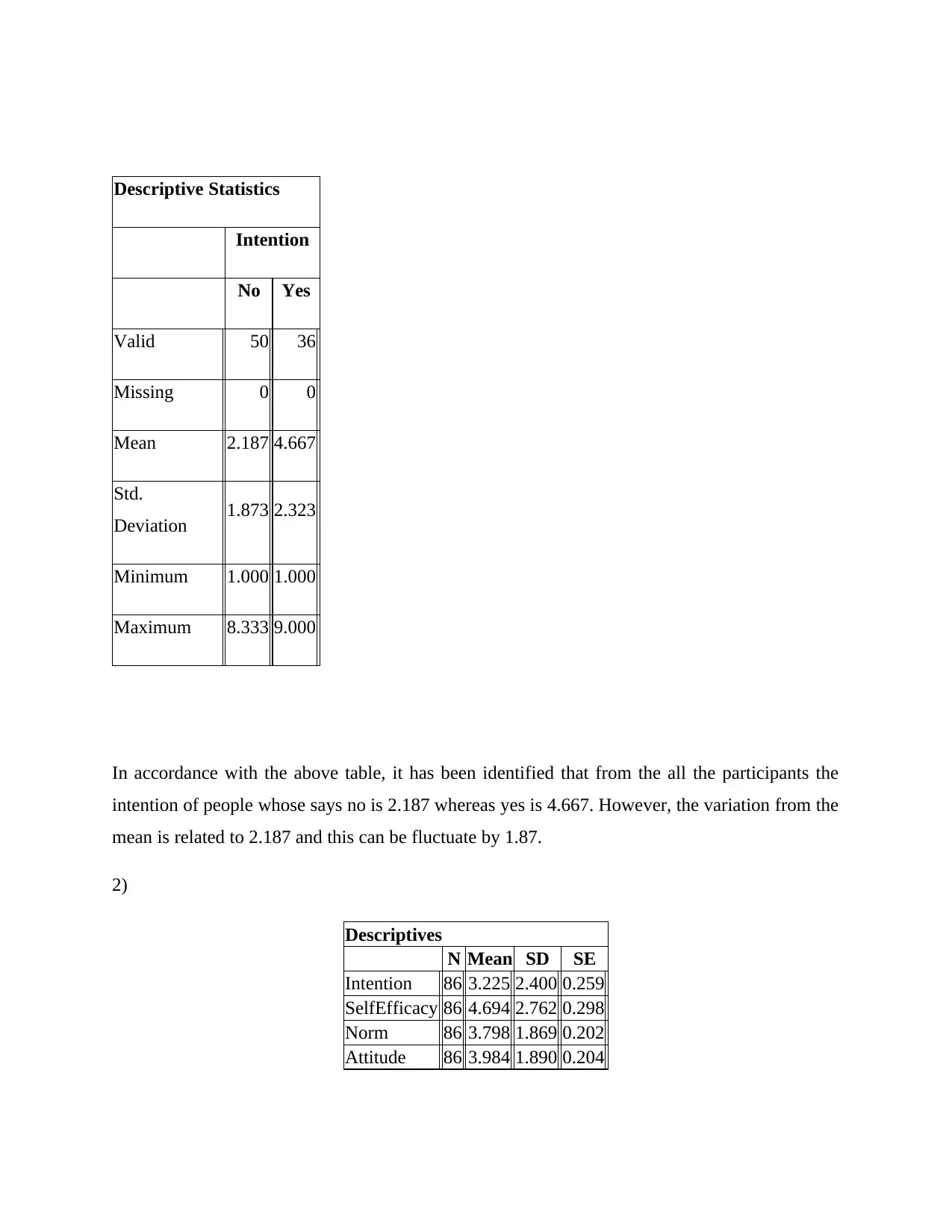
Descriptive Statistics
Intention
No Yes
Valid 50 36
Missing 0 0
Mean 2.187 4.667
Std.
Deviation 1.873 2.323
Minimum 1.000 1.000
Maximum 8.333 9.000
In accordance with the above table, it has been identified that from the all the participants the
intention of people whose says no is 2.187 whereas yes is 4.667. However, the variation from the
mean is related to 2.187 and this can be fluctuate by 1.87.
2)
Descriptives
N Mean SD SE
Intention 86 3.225 2.400 0.259
SelfEfficacy 86 4.694 2.762 0.298
Norm 86 3.798 1.869 0.202
Attitude 86 3.984 1.890 0.204
Intention
No Yes
Valid 50 36
Missing 0 0
Mean 2.187 4.667
Std.
Deviation 1.873 2.323
Minimum 1.000 1.000
Maximum 8.333 9.000
In accordance with the above table, it has been identified that from the all the participants the
intention of people whose says no is 2.187 whereas yes is 4.667. However, the variation from the
mean is related to 2.187 and this can be fluctuate by 1.87.
2)
Descriptives
N Mean SD SE
Intention 86 3.225 2.400 0.259
SelfEfficacy 86 4.694 2.762 0.298
Norm 86 3.798 1.869 0.202
Attitude 86 3.984 1.890 0.204
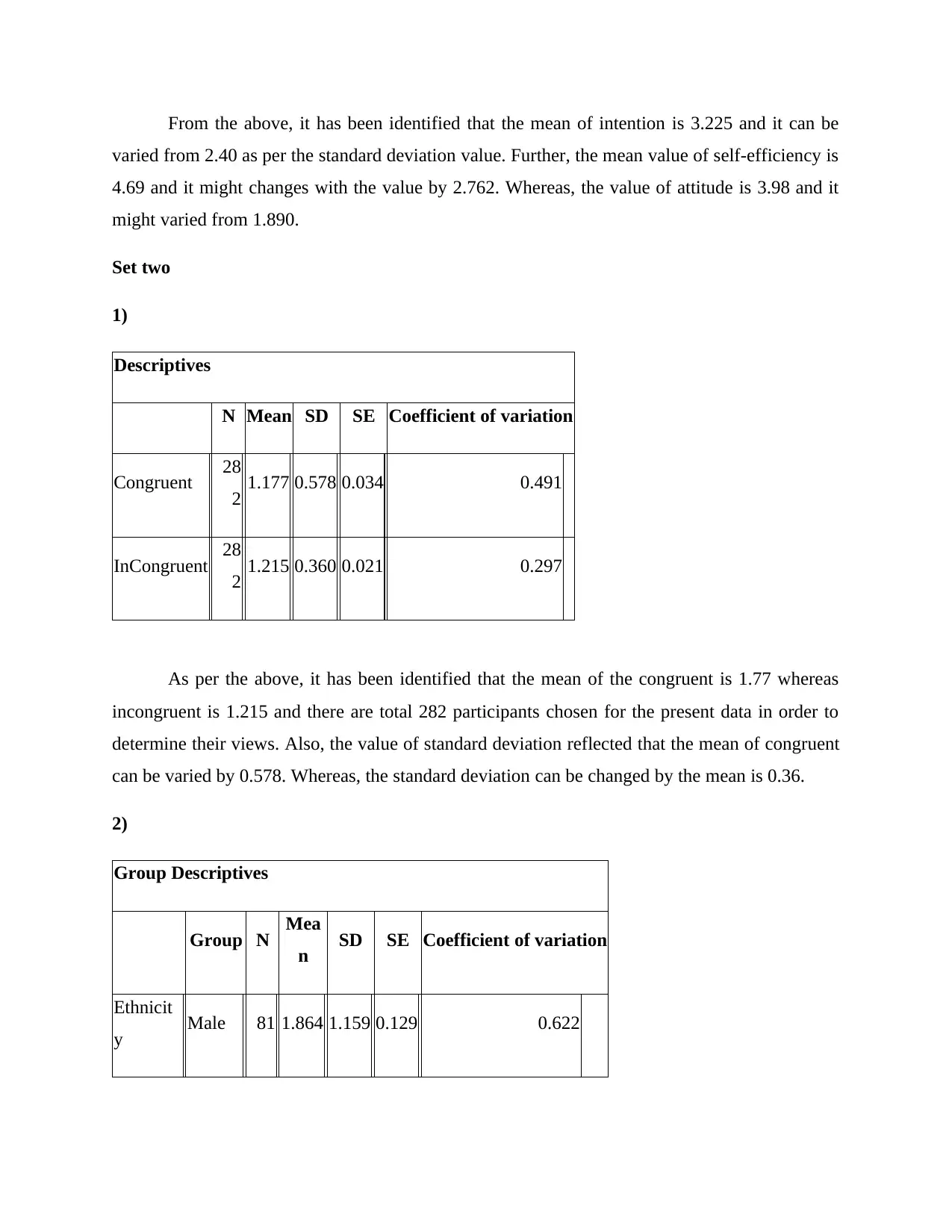
From the above, it has been identified that the mean of intention is 3.225 and it can be
varied from 2.40 as per the standard deviation value. Further, the mean value of self-efficiency is
4.69 and it might changes with the value by 2.762. Whereas, the value of attitude is 3.98 and it
might varied from 1.890.
Set two
1)
Descriptives
N Mean SD SE Coefficient of variation
Congruent 28
2 1.177 0.578 0.034 0.491
InCongruent 28
2 1.215 0.360 0.021 0.297
As per the above, it has been identified that the mean of the congruent is 1.77 whereas
incongruent is 1.215 and there are total 282 participants chosen for the present data in order to
determine their views. Also, the value of standard deviation reflected that the mean of congruent
can be varied by 0.578. Whereas, the standard deviation can be changed by the mean is 0.36.
2)
Group Descriptives
Group N Mea
n SD SE Coefficient of variation
Ethnicit
y Male 81 1.864 1.159 0.129 0.622
varied from 2.40 as per the standard deviation value. Further, the mean value of self-efficiency is
4.69 and it might changes with the value by 2.762. Whereas, the value of attitude is 3.98 and it
might varied from 1.890.
Set two
1)
Descriptives
N Mean SD SE Coefficient of variation
Congruent 28
2 1.177 0.578 0.034 0.491
InCongruent 28
2 1.215 0.360 0.021 0.297
As per the above, it has been identified that the mean of the congruent is 1.77 whereas
incongruent is 1.215 and there are total 282 participants chosen for the present data in order to
determine their views. Also, the value of standard deviation reflected that the mean of congruent
can be varied by 0.578. Whereas, the standard deviation can be changed by the mean is 0.36.
2)
Group Descriptives
Group N Mea
n SD SE Coefficient of variation
Ethnicit
y Male 81 1.864 1.159 0.129 0.622
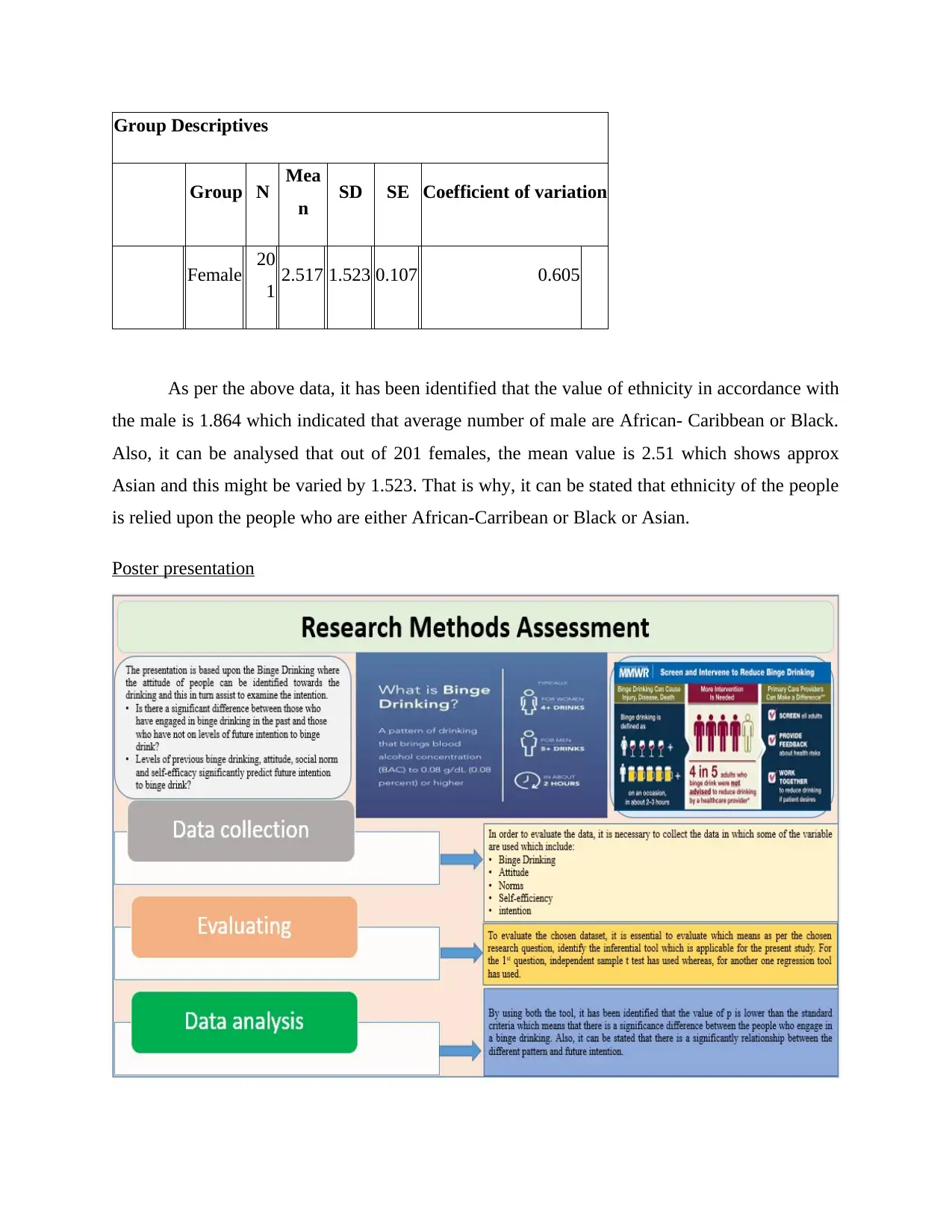
Group Descriptives
Group N Mea
n SD SE Coefficient of variation
Female 20
1 2.517 1.523 0.107 0.605
As per the above data, it has been identified that the value of ethnicity in accordance with
the male is 1.864 which indicated that average number of male are African- Caribbean or Black.
Also, it can be analysed that out of 201 females, the mean value is 2.51 which shows approx
Asian and this might be varied by 1.523. That is why, it can be stated that ethnicity of the people
is relied upon the people who are either African-Carribean or Black or Asian.
Poster presentation
Group N Mea
n SD SE Coefficient of variation
Female 20
1 2.517 1.523 0.107 0.605
As per the above data, it has been identified that the value of ethnicity in accordance with
the male is 1.864 which indicated that average number of male are African- Caribbean or Black.
Also, it can be analysed that out of 201 females, the mean value is 2.51 which shows approx
Asian and this might be varied by 1.523. That is why, it can be stated that ethnicity of the people
is relied upon the people who are either African-Carribean or Black or Asian.
Poster presentation
Paraphrase This Document
Need a fresh take? Get an instant paraphrase of this document with our AI Paraphraser

For the current poster, Binge Drinking as a study has chosen in which the data first collected by
selecting 86 participants. Here, different variables are used which include binge drink past, that
determine whether the selected participant actually drink it or not. Next is, how often past which
means that how frequently they drink the same. On the other side, third and onward variable are
attitude, norms, elf-efficiency, intention which reflected the number that determine the values
accordingly. The selected dataset determine the actual performance and the views of selected
participants so that the business can make decision accordingly.
Further, in the next stage i.e. evaluation has performed which identify how the dataset are
evaluated in order to perform the results in an effective manner. This can be performed by using
different inferential test which in turn assist to examine the results and create a better outcome.
In order to determine the answer of the provided research questions, accurate test need to be
applied that provide the results. In this, dependent and independent variable has choosen which
include future intention is dependent where as binge drinking, attitude, social norm and self-
efficacy are treated as an independent variable.
In the third stage, analysis has used that assist to analyse the results in an accurate
manner. Further, it can be stated that by applying independent sample t test in the chosen dataset
so that difference between those who have engaged in binge drinking in the past and those who
have not on levels of future intention to binge drink can be identified. The results generated from
the same reflected that there is a significant difference between the values as it is lower than
0.05. Further, another tool has used for the present dataset in order to predict the future intention
to binge drink. Such that alternative hypothesis has selected which in turn shows that the
association between the independent and dependent value is 0.81 which shows that there is
strong association between the variable. Whereas, the value of R square reflected that it create
66% changes over the dependent variable. This in turn shows that there will be high impact
identified over the future intention to binge drink when the level of previous binge drinking,
attitude, social norm and self-efficacy significantly changes.
Overall, it can be stated that with the help of such analysis tool, there will be a direct
impact identified over the dependent variable. This in turn shows that when the people have
selecting 86 participants. Here, different variables are used which include binge drink past, that
determine whether the selected participant actually drink it or not. Next is, how often past which
means that how frequently they drink the same. On the other side, third and onward variable are
attitude, norms, elf-efficiency, intention which reflected the number that determine the values
accordingly. The selected dataset determine the actual performance and the views of selected
participants so that the business can make decision accordingly.
Further, in the next stage i.e. evaluation has performed which identify how the dataset are
evaluated in order to perform the results in an effective manner. This can be performed by using
different inferential test which in turn assist to examine the results and create a better outcome.
In order to determine the answer of the provided research questions, accurate test need to be
applied that provide the results. In this, dependent and independent variable has choosen which
include future intention is dependent where as binge drinking, attitude, social norm and self-
efficacy are treated as an independent variable.
In the third stage, analysis has used that assist to analyse the results in an accurate
manner. Further, it can be stated that by applying independent sample t test in the chosen dataset
so that difference between those who have engaged in binge drinking in the past and those who
have not on levels of future intention to binge drink can be identified. The results generated from
the same reflected that there is a significant difference between the values as it is lower than
0.05. Further, another tool has used for the present dataset in order to predict the future intention
to binge drink. Such that alternative hypothesis has selected which in turn shows that the
association between the independent and dependent value is 0.81 which shows that there is
strong association between the variable. Whereas, the value of R square reflected that it create
66% changes over the dependent variable. This in turn shows that there will be high impact
identified over the future intention to binge drink when the level of previous binge drinking,
attitude, social norm and self-efficacy significantly changes.
Overall, it can be stated that with the help of such analysis tool, there will be a direct
impact identified over the dependent variable. This in turn shows that when the people have

changes over the binge drinking and attitude then it causes a direct impact over the future
intention. As the p value also reflected there is an alternative hypothesis has selected which
entails that 0.01 is lower than 0.05 and that is why, it can be stated that it will create a direct
impact over the dependent variable. Also, it has been analysed that with the change in the
different factor, the people intention might be varied and that is why, it can be stated that it helps
to make changes in the decision of a company.
intention. As the p value also reflected there is an alternative hypothesis has selected which
entails that 0.01 is lower than 0.05 and that is why, it can be stated that it will create a direct
impact over the dependent variable. Also, it has been analysed that with the change in the
different factor, the people intention might be varied and that is why, it can be stated that it helps
to make changes in the decision of a company.
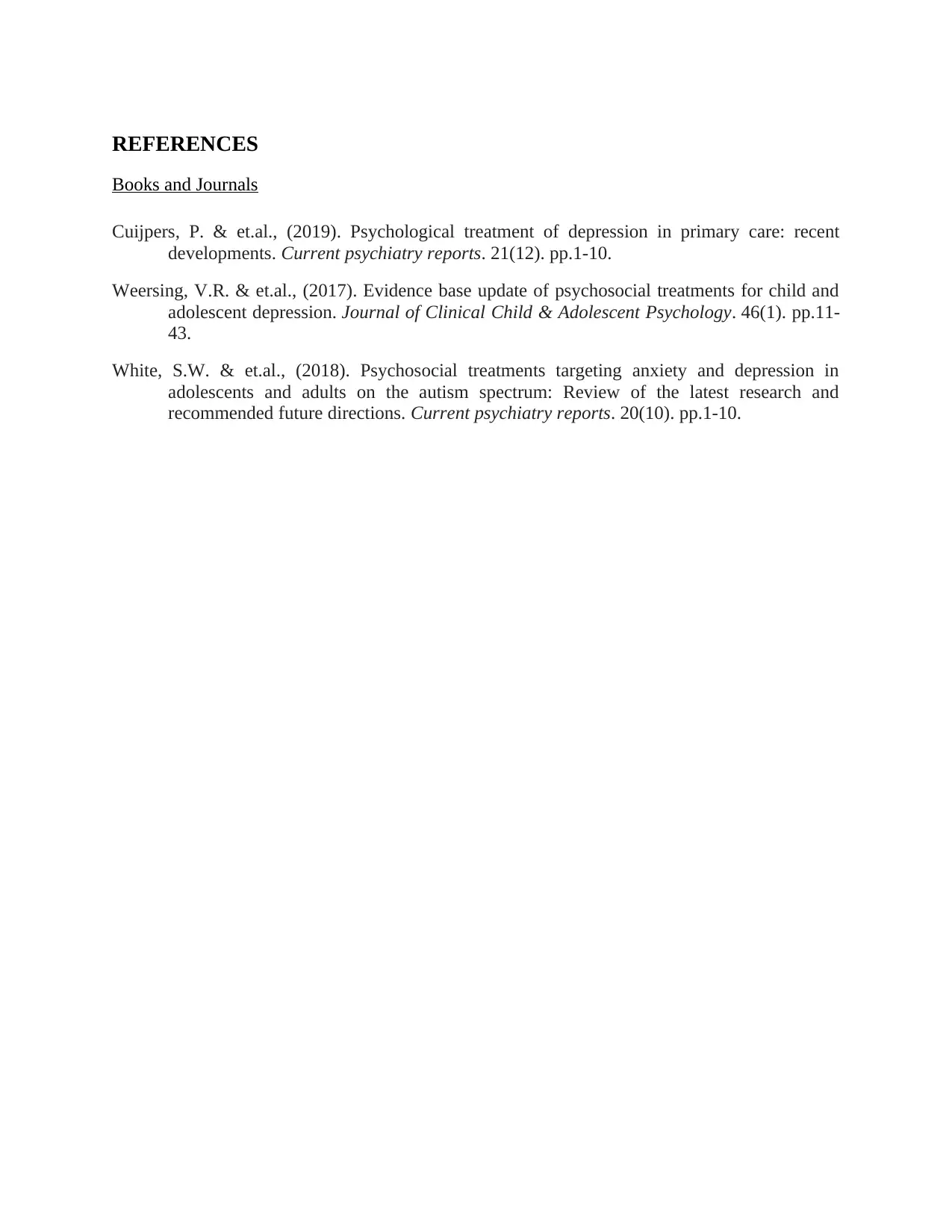
REFERENCES
Books and Journals
Cuijpers, P. & et.al., (2019). Psychological treatment of depression in primary care: recent
developments. Current psychiatry reports. 21(12). pp.1-10.
Weersing, V.R. & et.al., (2017). Evidence base update of psychosocial treatments for child and
adolescent depression. Journal of Clinical Child & Adolescent Psychology. 46(1). pp.11-
43.
White, S.W. & et.al., (2018). Psychosocial treatments targeting anxiety and depression in
adolescents and adults on the autism spectrum: Review of the latest research and
recommended future directions. Current psychiatry reports. 20(10). pp.1-10.
Books and Journals
Cuijpers, P. & et.al., (2019). Psychological treatment of depression in primary care: recent
developments. Current psychiatry reports. 21(12). pp.1-10.
Weersing, V.R. & et.al., (2017). Evidence base update of psychosocial treatments for child and
adolescent depression. Journal of Clinical Child & Adolescent Psychology. 46(1). pp.11-
43.
White, S.W. & et.al., (2018). Psychosocial treatments targeting anxiety and depression in
adolescents and adults on the autism spectrum: Review of the latest research and
recommended future directions. Current psychiatry reports. 20(10). pp.1-10.
1 out of 16
Related Documents
Your All-in-One AI-Powered Toolkit for Academic Success.
+13062052269
info@desklib.com
Available 24*7 on WhatsApp / Email
![[object Object]](/_next/static/media/star-bottom.7253800d.svg)
Unlock your academic potential
© 2024 | Zucol Services PVT LTD | All rights reserved.

![[DOWNLOAD] Descriptive Study Analysis](/_next/image/?url=https%3A%2F%2Fdesklib.com%2Fmedia%2Fimages%2Fhh%2F5dd3f7cd96134d78a9296dad9e8e44a8.jpg&w=256&q=75)


